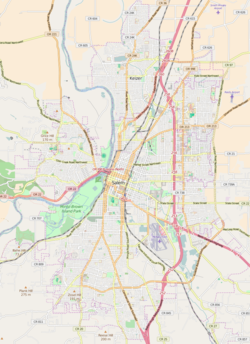This article needs to be updated.(January 2015) |
Thomas Kay Woolen Mill | |
 Thomas Kay Woolen Mill from the rear, showing the dye house | |
| Location | Salem, Oregon, U.S. |
|---|---|
| Coordinates | 44°56′6″N123°1′37″W / 44.93500°N 123.02694°W |
| Built | 1889 |
| Architect | Walter D. Pugh |
| Website | willametteheritage |
| NRHP reference No. | 73001579 |
| Added to NRHP | May 8, 1973 |
Willamette Heritage Center is a museum in Salem, Oregon, United States. The five-acre site features several structures listed on the National Register of Historic Places, including the Thomas Kay Woolen Mill, [1] the Jason Lee House, [2] Methodist Parsonage, [3] John D. Boon House, and the Pleasant Grove (Condit) Church. [4] [5] The houses and church were relocated to the mill site. The Center also includes a research library and archives of Marion County history. Today, the Willamette Heritage Center offers self-guided tours, event rental spaces, educational classes, and also hosts local events for the community.
Contents
The Center was created in 2010 from the merger of the Mission Mill Museum Association (est. 1964) and the adjacent Marion County Historical Society (est. 1950). [6] [7]




